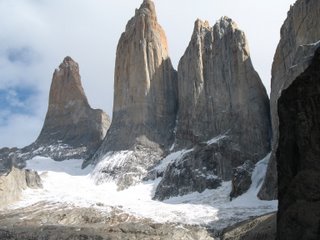The Inca Trail to Machu Piccu
It was a cloudy day as we set off, 14 gringos (a friendly group of mostly Brits, a few Aussies and a Kiwi), 20 porters and 2 guides - there must be more porters than tourists on the Inca trail! However, this does mean you are treated to a deluxe camping experience. All the meals are served inside a large tent and even chairs are provided! The food was very good, we were amazed at what they were able to knock up in the middle of nowhere. The first day was a leisurely four hours up to the village of Wayllabamba at 3000m. The next day we crossed the 4200m Dead Woman´s Pass, a relentless three hour climb with the gradient and the altitude taking their toll. At the summit, it began raining and a steep slippery descent took us down to the camp site at 3600m, where a cold night awaited us.
From here the trail follows mostly original Inca paving, initially up a steep pass past the ruins of Runkuracay, a fortified lookout, to the top of the second pass. A clear day resulted in great views out towards the Cordillera Vilcabamba as the trail descended to the Sayacmarca ruins. The name means inaccessible town and it was thought to be a staging post en route to Machu Piccu. The ruins have a fantastic setting looking out across numerous converging trails. As the mist rolled in, a gradual climb took us to the top of the third pass, through a section of cloud forest, thick with bamboo, bromeliads and hanging mosses. Near the summit lies the ruins of Phuyupatamarca, an Inca bathing site. A steep staircase led us down through the bamboo forest past the agricultural terraces of Wiñay Wayna to the final campsite.
The final section of trail, which had been damaged by a recent landslide, was now open again. Its only an hours walk through forest and up some steep steps to the Sun Gate, from where Machu Piccu is finally revealed. Its a breathtaking first sight - the city surrounded by mountains on all sides. As you walk down, the ruins take shape, culminating in the classic view point where the ruins are framed by the mountain of Wayna Picchu. Despite being the most famous of all the Inca sites, little is known of the true function of this lost city. It was thought to have been constructed during the 1400s, towards the end of the reign of the Incas and was never discovered by the Spanish. It was rediscovered in 1911 by American explorer Hiram Bingham. The current thinking is that the site was a retreat for the Inca elite as well as also serving some ceremonial purposes. The site contains three important temples, numerous dwellings and some impressive terraces. Sixty percent of the site is original Inca stonework, the rest was reconstructed by Bingham. After enjoying the site itself, a few of us climbed the steep path up Wayna Picchu mountain to enjoy a unique perspective of the city. I had been looking forward to visiting Machu Piccu for some years now, suffice to say I was not disappointed by the amazing setting of what must rank as one of the wonders of the modern world.
From here the trail follows mostly original Inca paving, initially up a steep pass past the ruins of Runkuracay, a fortified lookout, to the top of the second pass. A clear day resulted in great views out towards the Cordillera Vilcabamba as the trail descended to the Sayacmarca ruins. The name means inaccessible town and it was thought to be a staging post en route to Machu Piccu. The ruins have a fantastic setting looking out across numerous converging trails. As the mist rolled in, a gradual climb took us to the top of the third pass, through a section of cloud forest, thick with bamboo, bromeliads and hanging mosses. Near the summit lies the ruins of Phuyupatamarca, an Inca bathing site. A steep staircase led us down through the bamboo forest past the agricultural terraces of Wiñay Wayna to the final campsite.
The final section of trail, which had been damaged by a recent landslide, was now open again. Its only an hours walk through forest and up some steep steps to the Sun Gate, from where Machu Piccu is finally revealed. Its a breathtaking first sight - the city surrounded by mountains on all sides. As you walk down, the ruins take shape, culminating in the classic view point where the ruins are framed by the mountain of Wayna Picchu. Despite being the most famous of all the Inca sites, little is known of the true function of this lost city. It was thought to have been constructed during the 1400s, towards the end of the reign of the Incas and was never discovered by the Spanish. It was rediscovered in 1911 by American explorer Hiram Bingham. The current thinking is that the site was a retreat for the Inca elite as well as also serving some ceremonial purposes. The site contains three important temples, numerous dwellings and some impressive terraces. Sixty percent of the site is original Inca stonework, the rest was reconstructed by Bingham. After enjoying the site itself, a few of us climbed the steep path up Wayna Picchu mountain to enjoy a unique perspective of the city. I had been looking forward to visiting Machu Piccu for some years now, suffice to say I was not disappointed by the amazing setting of what must rank as one of the wonders of the modern world.


0 Comments:
Post a Comment
<< Home